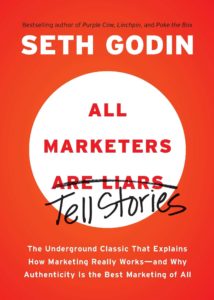All Marketers Tell Stories

All Marketers Tell Stories by Seth Godin helped me understand why I feel that marketing is a dirty job. It says, that the marketing process is about making someone feel a certain way, rather than them feeling it on their own. On one hand, this seems like psychological trickery, on the other, it seems obvious that even our day-to-day lives are about making people feel things.
The broad concept of the book is simple, we understand the world through stories, and that feelings matter more than fact.
Stories make it easier to understand the world. Stories are the only way we know to spread an idea.
The facts are irrelevant. In the short run, it doesn’t matter one bit whether something is actually better or faster or more efficient. What matters is what the consumer believes.
We’d like to believe that people are rational and informed. They are neither.
But what does the consumer believe in, and how do we use that to tell our story?
Worldview refers to the rules, values, beliefs and biases that an individual consumer brings to a situation. Frames are elements of a story painted to leverage the worldview a consumer already has.
Don’t try to change someone’s worldview is the strategy smart marketers follow. Don’t try to use facts to prove your case and to insist that people change their biases…Insead, identify a population with a certain worldview, frame your story in terms of that worldview and you win.
Your opportunity lies in finding a neglected worldview, framing your story in a way that this audience will focus on and going from there.
Storytellers need an audience, and the story will have a wider reach if the audience is willing to re-tell the story:
People clump together into common worldviews, and your job is to find a previously undiscovered clump and frame a story for those people.
It’s not enough to find a niche that shares a worldview. That niche has to be ready and able to influence a large group of their friends.
…communities share (some) worldviews… What makes them a community is that they talk to each other… the best marketing goes on when you talk to a group that shares a worldview and also talks about it—a community.
The author gives a few guidelines to help us frame our own stories:
Every consumer has a worldview that affects the product you want to sell. That worldview alters the way they interpret everything you say and do. Frame your story in terms of that worldview, and it will be heard.
People only notice stuff that’s new and different. And the moment they notice something new, they start making guesses about what to expect next.
In order to survive the onslaught of choices, consumers make snap judgements.
Humans are able to make extremely sophisticated judgements in a fraction of a second. And once they’ve drawn that conclusion, they resist changing it.
Stories let us lie to ourselves. And those lies satisfy our desires. It’s the story, not the good or the service you actually sell, that pleases the consumer.
I didn’t quite understand this last point. How does a good story replace good service? The customer is going to find the lie and stop believing the story.
Not sure if it is my lack of understanding, or a contradiction in the book, but the author shifts gears here. They say that the story needs to be told by every aspect of the business and not just their marketing material and that the business needs to live the story, not just tell it:
I’m not letting you off the hook by encouraging you to tell stories. In fact, stories only magnify the need to have something remarkable and honest to say.
If a consumer figures something out or discovers it on her own, she’s a thousand times more likely to believe it than if it’s just something you claim… You have to hint at the facts, not announce them. You cannot prove your way into a sale–you gain a customer when the customer proves to herself that you’re a good choice.
The book then shares some tips from case studies:
You succeed by being an extremist in your storytelling, then gracefully moving your product or service to the middle so it becomes more palatable to audiences that are persuaded by their friends, not by you
Your goal should not be to create a story that is quick, involves no risks and is without controversy. Boredom will not help you grow.
You can’t change a person’s worldview easily, but you can take advantage of the opportunity that presents itself when the world changes it for them.
The author also gives a convenient funnel through which every story goes. When our stories fail, this helps us understand where we could improve.
New releases fail if no one noticed it, noticed but didn’t try, tried but didn’t continue using it, used it but didn’t tell their friends.
While I am still confused about aspects of the book, at least it gave me some direction to think about marketing.I don’t have any other books on this topic on my reading list so recommendations are very welcome.